

|
 Nearly
all of Bob Hope's sixty-year broadcasting career was in programs
carried by the radio and television networks of the National
Broadcasting Company (NBC). When NBC was established in 1926
it was the first commercial broadcasting network in the world.
In its early years, NBC operated two networks, the Red and
the Blue. The Blue Network was sold in 1943 and became the
American Broadcasting Company (ABC). Nearly
all of Bob Hope's sixty-year broadcasting career was in programs
carried by the radio and television networks of the National
Broadcasting Company (NBC). When NBC was established in 1926
it was the first commercial broadcasting network in the world.
In its early years, NBC operated two networks, the Red and
the Blue. The Blue Network was sold in 1943 and became the
American Broadcasting Company (ABC).
The NBC Collection at the Library of Congress, comprised
of radio recordings, television kinescope motion pictures,
scripts, press releases, and business papers, is the largest
and most comprehensive broadcasting company archive collection
in the United States. The collection documents the rise and
development of both radio and televison entertainment.
Bob Hope conquered the radio medium at nearly the same time
as he found success in motion pictures. Hope was featured
regularly in several radio series throughout the 1930s. His
success in the film The Big Broadcast of 1938 brought
him to The Pepsodent Show radio series, which
aired for over ten years as a top-rated program. The
Pepsodent Show enjoyed enormous success for many
reasons. Hope, by 1938 a veteran entertainer, had established
a very popular persona: brash, yet not too serious about
himself, and a comic wiseacre who endeared himself to his
audience by taking them into his confidence. The format of
the Pepsodent Show was straightforward: a monolog
by Hope, exchanges and skits with his regular cast and guest
stars, and a concluding skit. The manic comic character of
his Pepsodent sidekick, Jerry Colonna, was
also a popular attraction on the show, but it was Bob Hope's
opening monolog which rooted each week's installment.
The May 6, 1941, installment of Bob Hope's popular Pepsodent
radio series aired from March Army Air Force Field in Riverside,
California. This was the first remote broadcast of Hope's
coast-to-coast radio program and became the first of hundreds
of radio and television broadcasts Hope performed for the
entertainment of U.S. soldiers. Broadcasting in front of
a live audience of soldiers and gearing the subject matter
of the monolog to the troops, Hope fashioned a very successful
variant on the radio comedy variety format. World War II-era
stateside radio audiences, as well as the troops, appreciated
Hope's soldier-directed monologs, which provided home audiences
with a special affinity with the soldiers' lives and their
contributions to the country.
|
|
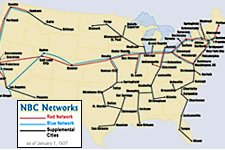
Map of NBC stations in 1937.
Created May 2000.
Library of Congress (85)
|
Map of NBC Stations in 1937
By 1927, NBC had two radio networks: the Red Network and
the Blue Network, each with affiliate stations across the
country. Together, these two networks delivered programs
to audiences nationwide, and delivered a national audience
to advertisers. On the radio, a vaudevillian's tour was instantaneous,
over the networks' telephone wire connections between cities
and stations, rather than by railroads over the course of
a year.
|
Bob Hope's NBC microphone
Bob Hope used this microphone at NBC radio.
|

NBC microphone,
ca. 1940.
Courtesy of Bob Hope Enterprises (86)
|
|
Network Logbooks
|
|
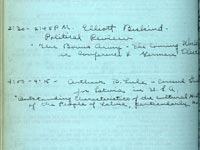
WEAF Corrected Traffic Sheets,
1932.
Log Book.
NBC Collection,
Motion Picture, Broadcasting
and Recorded Sound Division (87a)
|
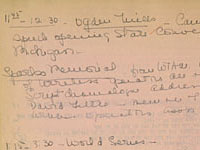
WEAF Corrected Traffic Sheets,
1932.
Log Book.
NBC Collection,
Motion Picture, Broadcasting
and Recorded Sound Division (87b)
|
|
NBC's radio logbooks, now at the Library of Congress, document
daily programming, including exactly which stations carried
each program supplied by the network. NBC normally placed
its more popular programs on the Red network and relied on
the Blue network to carry most of its public affairs and
cultural programs, often without commercial sponsors.
|
|
Lacquer Disc Recording of The Pepsodent Show
Beginning in 1934 the lacquer disc was used for recording
and preserving sound. Until the development of the lacquer
discs "instantaneous" recording was difficult and few recordings
were made of radio broadcasts This invention enabled radio
networks to record programming, and to make copies for artists,
sponsors, legal representatives, etc. Recording on lacquer
discs, NBC created an archive of its network radio shows.
The Library of Congress now holds 150,000 of these radio
discs in its NBC Archives collections.
|

Recording of The Pepsodent
Show,
February 3, 1948.
Lacquer disk.
Bob Hope Collection,
Motion Picture, Broadcasting
and Recorded Sound Division (88)
|
|
Artist Cards for Jack Benny and Fred Allen
|
|
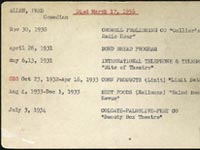
Artist card for Fred Allen's
radio performances, 1930-1934.
NBC Collection,
Motion Picture, Broadcasting
and Recorded Sound Division (89a)
|

Artist card for Jack Benny's radio performances
1930-1934.
NBC Collection,
Motion Picture, Broadcasting
and Recorded Sound Division (89b)
|
|
From 1930 to 1960 NBC staff documented on "artist cards" each
appearance of a performer on network radio programs. These
cards for Jack Benny and Fred Allen are from the set of artist
cards available in the Library's Recorded Sound Reference
Center.
|
|
|
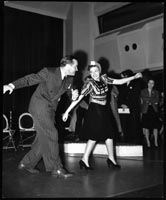
Bob Hope and Judy Garland,
ca. 1940.
Copyprint.
Bob Hope Collection,
Motion Picture, Broadcasting
and
Recorded Sound Division (89C.1)
|
"Are you sure you'll feel at home on this program?"
"Oh, yes, Mr. Hope...you should have seen the strange creatures I worked with
in the Wizard of Oz."
Judy Garland's career was as varied as that
of Bob Hope. Her first professional work was with her sisters
in a vaudeville child act. Garland was a regular cast member
of The Pepsodent Show from September 1939 (soon
after the premiere of The Wizard of Oz), to
May 1940. Each week she sang, engaged in repartee with Hope,
and participated in the comic skits.
|
Radio Personalities Jack Benny and Fred Allen
Jack Benny (1894-1974) and Fred Allen (1894-1956) were both
vaudevillians who found great success in radio. A popular
feature of their programs of the 1930s and 1940s was the
phony rivalry with each other which they perpetuated.
|
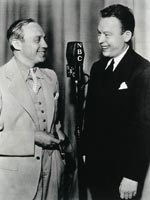
Jack Benny and Fred Allen,
1936.
Copyprint.
Prints and Photographs
Division (89c)
|
|

Jack Benny and Bob Hope
publicity photograph,
ca. 1940.
Copyprint.
Bob Hope Collection,
Motion Picture, Broadcasting
and Recorded Sound Division (89C.2)
|
Jack Benny and Bob Hope
Jack Benny and Bob Hope at times did guest spots on each
other's shows. The amiable banter between the two hosts was
a favorite segment of these joint appearances. They remained
friends up until Benny's death in 1974.
|
|
Sponsor cards for Jack Benny and Fred Allen
|
|
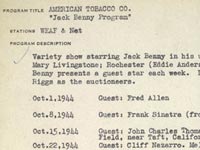  Sponsor
card for Sponsor
card for
Jack Benny's radio program, 1944
and
Fred Allen's radio program, 1949.
NBC Collection,
Motion Picture, Broadcasting
and Recorded Sound Division (90a, 90b)
|
|
Commercial programs carried by NBC radio were documented
in detail by NBC staff on cards that were filed by the name
of the advertiser. The "Sponsor File" describes each program's
format, including variations introduced over its run on the
air, and often lists the guests who appeared on each episode.
|
|
"...Nobody wants his stuff on the air"
|
|
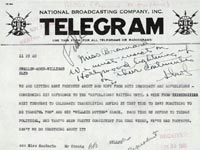
Telegram,
November 19, 1940.
NBC Collection,
Motion Picture, Broadcasting
and Recorded Sound Division (92)
|
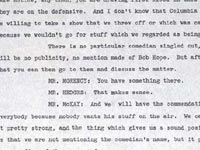
"Proceedings NBC War Clinic,"
New York, 1942.
Typewritten manuscript.
NBC Collection,
Motion Picture, Broadcasting &
Recorded Sound Division (92-s1)
|
|
Even when Bob Hope's radio program was rated #1, NBC management
fretted over Hope's radio monologs, which were occasionally
racy in addition to being topical. The network was always
careful not to offend listeners nor to anger sponsors or
the government. This telegram expresses an NBC executive's
concern over Hope's comments on the 1940 Presidential election.
The full extent of their concern is evident in these notes
from a 1942 management meeting that indicate that serious
consideration was given to canceling Hope's show.
|
|
|
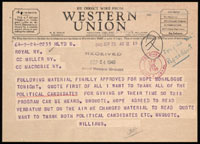
Telegram,
September 25, 1940.
NBC Collection,
Motion Picture, Broadcasting
and Recorded Sound Division (92.2)
|
NBC Telegram About Bob Hope
NBC Radio management fretted about Bob Hope's radio monologs,
which were always topical and occasionally racy. The transgression
described in this 1940 telegram seems to be minor but it
warranted a telegram that NBC saved for more than fifty years.
In this case, Hope chose to ignore the network's request
for a minor script change.
|
|
|
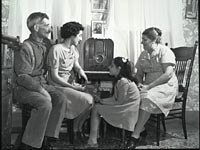
John Collier.
Family of a Portuguese dory fisherman.
Massachusetts:
US Office of
War Information, 1942.
Copyprint.
Prints and Photographs Division (93a)
|
|
Ed Wynn as "The Fire Chief"
Ed Wynn (1886-1966)is credited with producing the first
comedy program on radio, a mounting of his revue, The
Perfect Fool, for broadcast on February 19, 1922.
Wynn is said to have become the first radio performer to
have a studio audience when he rounded up station employees
to witness the broadcast because he found it difficult to
be funny without an audience to respond to his humor. Wynn's
strong ties to stage entertainment also caused him to wear
a costume during his radio broadcasts. He is seen here performing
in his most popular radio series, The Texaco Fire Chief, which
ran from 1932 to 1935.
|
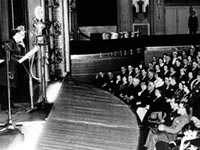
Ed Wynn as
"The Fire Chief,"
ca. 1935.
Copyprint.
Prints and Photographs
Division (94)
|
|

Radio Round-Ups.
Boston: Lothrop, Lee, and
Shepard, 1932.
Page 2
General Collections (95)
|
Radio Information
As radio grew in popularity, fans became interested in learning
more about its stars, seeing what they looked like and learning
inside information about them. Radio Round-Ups satisfied
this curiosity and further promoted the programs.
|
|
Cross Promotion
|
|
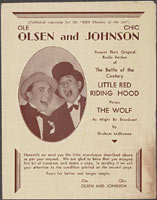
"Olsen and Johnson,"
ca. 1935.
Printed pamphlet.
Bob Hope Collection,
Motion Picture, Broadcasting
and
Recorded Sound Division (96a)
|
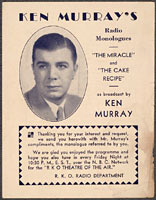
"Ken Murray's Radio Monologues,"
ca. 1934.
Page 2
Printed pamphlet.
Bob Hope Collection,
Motion Picture, Broadcasting
and
Recorded Sound Division (96b)
|
|
The commercial sponsor of these vaudevillians' radio programs,
a vaudeville and motion picture theater chain, printed these
pamphlets for free distribution to fans. The keepsakes remind
fans of the ties between the popular stars and their radio
sponsors.
|
|
Headlines from Variety and the Boston
Globe
|
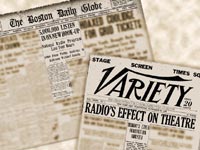 |
"5,000,000 Listen
in on New Hook-Up."
The Boston Daily Globe,
November 16, 1926.
Reproduction.
Serial and Government
Publications Division (97b)
"Radio's Effect
on Theatre,"
Variety, November 17, 1926.
Reproduction.
General Collections (97a)
|
|
The inaugural broadcast of the National Broadcasting Company
aired on the evening of November 15, 1926. Highlights of
the radio extravaganza included humorist Will Rogers, a variety
of dance orchestras, comedy team Weber and Fields, the New
York Symphony lead by Walter Damrosch, soprano Mary Garden,
baritone Titta Ruffo, and Edwin Franko Goldman's band. The
program lasted more than four hours.
|
|
|
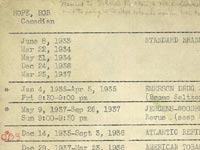
Bob Hope artist card, 1944.
NBC Collection,
Motion Picture, Broadcasting
and Recorded Sound Division (98)
|
Bob Hope Artist Card
This is the first Bob Hope card in NBC's "Artist File," a
listing of artists' radio appearances on the network. The
card lists all of Hope's guest appearances in the 1930s in
addition to the programs on which he was regularly featured
prior to the debut of The Pepsodent Show.
|
Woodbury Program Audition Sheet
Hope's Rippling Rhythm radio program, sponsored
by Woodbury Soap, first aired on May 9, 1937. This audition
sheet from a month before Rippling Rhythm aired
shows that neither Shep Fields nor Frank Parker, costars
of the Woodbury program, were originally intended for the
series. Until the 1950s, most commercial radio programs were
produced by advertising agencies hired by the shows' sponsors.
Note that the preprinted production form includes a list
of all sound effects needed during the broadcast.
|
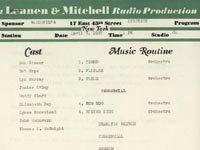
Woodbury Program Audition
Sheet,
April 9, 1937.
Bob Hope Collection,
Motion Picture, Broadcasting
and Recorded Sound Division (100)
|
|
"This is Bob 'Football' Hope" telling you
to always use Pepsodent
because it's better to set out for a nice run than to run
out for a nice set!"
|
|
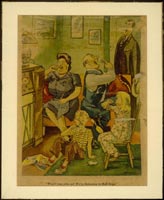
Cartoon, 1940s.
Newspaper cartoon.
Bob Hope Collection,
Motion Picture, Broadcasting
and
Recorded Sound Division (100A)
|
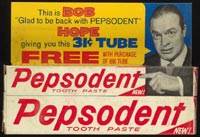
Pepsodent Toothpaste Box,
1940s.
Courtesy of Bob Hope Archives (102b)
|
|
Pepsodent toothpaste was the sole sponsor of Bob Hope's
comedy variety radio program from 1938 to 1948. Each program
included ads delivered by the announcer and comic references
to Pepsodent products scattered throughout the script. The
program was such a success, for Pepsodent, as well as Hope,
that Hope became inextricably tied to the product.
|
|

Radio Daily,
December 23, 1941.
Bob Hope Collection,
Motion Picture, Broadcasting
and Recorded Sound Division (102a)
|
Hope's Popularity on Radio in the 1940s
As this newspaper shows, in December of 1941 radio critics
voted Bob Hope their favorite entertainer and comedian. In
1943 The Pepsodent Show beat Jack Benny's Jell-O
Show as the number one-rated radio program. Hope attributed The
Pepsodent Show's success to his formula of beginning
the program with a fast-paced monolog of jokes- "speed comedy," as
he called it.
|
Hope and Troops
During World War II nearly every weekly Bob Hope Pepsodent
Show was broadcast from an armed forces installation
in the United States. For example, Hope's first five broadcasts
in 1945 were aired from Yuma, Arizona; Terminal Island,
California; Fort Monmouth, New Jersey; Quonset Point, Rhode
Island; and Tampa, Florida.
|
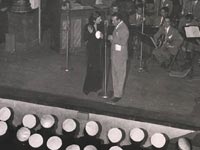
Bob Hope with troops,
December 7, 1943.
Bob Hope Collection,
Motion Picture, Broadcasting
and Recorded Sound Division (103)
|
|
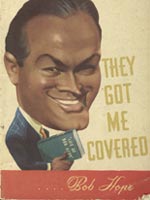
Bob Hope.
They Got Me Covered.
Hollywood: 1941.
Bob Hope Collection,
Motion Picture, Broadcasting
and Recorded Sound Division (104)
|
Bob Hope's First Autobiography
Bob Hope's first autobiography, They Got Me Covered, was
a promotional premium written to publicize his Pepsodent
Show on radio. Copies were sold to the public through
Pepsodent for ten cents each.
|
"This is Bob (March Field) Hope"
As United States armed forces trained for possible entry
into World War II, Bob Hope's Pepsodent Show aired for the
first time from a military installation on May 6, 1941. Nearly
every subsequent Hope radio program during World War II was
broadcast on location, in front of an audience of soldiers.
This opening monolog from that first show includes all the
ingredients which would endear him to millions of soldiers
and civilians during World War II -- local and topical
references, self-deprecating quips, and military-related
inside humor.
|
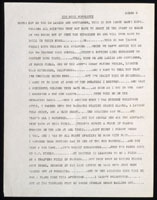
Script pages from The
Pepsodent Show.
Typewritten manuscript,
Bob Hope Collection,
Motion Picture, Broadcasting
and Record Sound Division (104.1a, b)
|
|
Thanks for the Memory dedicated
to FDR |
|
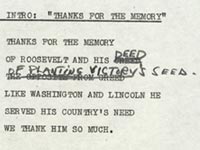
"Thanks
for the Memory" lyrics,
1945.
Typed manuscript with
handwritten emendations.
Bob Hope Collection,
Motion Picture, Broadcasting
and Recorded Sound Division (105)
|

"Thanks for the Memory,"
handwritten lyrics on envelope, 1942.
Page 2
Bob Hope Collection,
Motion Picture, Broadcasting
and Recorded Sound Division (105A)
|
Bob Hope adopted "Thanks for the Memory" as his personal
theme song soon after the success of The Big Broadcast of 1938.
He concluded most of his broadcasts and personal appearances
with a version of this song custom-written for each performance.
The artifacts
shown here demonstrate some of the types of adaptations.
In December of 1942, Hope entertained the troops at Casper
Air Force Base in Wyoming.
He personally wrote a version (above, right) of "Thanks
for the Memory" for the Casper performance.
On his Pepsodent Show of April 17, 1945, five days after
the death of President Franklin D. Roosevelt, Hope sang another
version of the song in a moving tribute to the president
(above, left). |
|
Radio-TV Mirror Award
Readers of the magazine Radio-TV Mirror chose
Bob Hope as their favorite radio comedian in several annual
polls, including that of the 1952-1953 season for which this
medal was awarded.
|
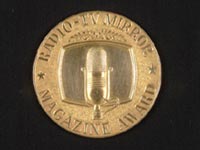
Radio-TV Mirror award, 1953.
Gold medal.
Courtesy of Bob Hope (106)
|
|
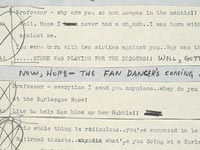
Radio script draft,
February 22, 1944.
Handwritten manuscript.
Bob Hope Collection,
Motion Picture, Broadcasting
and Recorded Sound Division (106a)
|
Bob Hope Radio Script Draft
For each Tuesday night's Pepsodent Show, Bob
Hope and his writers would create a draft script which was
intentionally longer than required for the half-hour program.
On the Sunday before the broadcast Hope and his cast would
rehearse the long script in front of an audience at NBC's
studios. The audience's reaction to each joke would be gauged,
and the most successful gags became part of the final script
for Tuesday's broadcast. The checked circles on each segment
of this radio script draft indicate that the rehearsal audience
liked the exchange between Hope and Jerry Colonna.
|
Photograph of Hope and His Radio Program Writers
Much of Bob Hope's success on radio can be attributed to
the hard work that the writers and Hope himself put into
each broadcast. Hope's method was to meet with his writers
to discuss ideas for the each week's program. The writers
would then break into teams, each of which composed a complete
script. The most successful parts of each creation would
form the script draft.
|
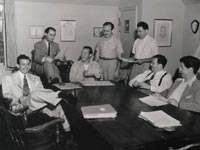
Bob Hope with writers,
ca. 1946.
Copyprint.
Bob Hope Collection,
Motion Picture, Broadcasting
and Recorded Sound Division (106b)
|
|
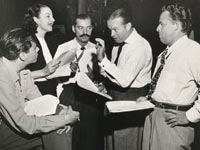
The Pepsodent Show cast,
ca. 1946.
Copyprint.
Bob Hope Collection,
Motion Picture, Broadcasting
and Recorded Sound Division (107)
|
The Pepsodent Show Cast
The Pepsodent Show cast of the 1946-1947 radio
season included (l-r): Desi Arnaz, bandleader; Vera Vague;
Jerry Colonna; Bob Hope; and Wendell Niles, announcer.
|
Jerry Colonna
Bob Hope's sidekick on The Pepsodent
Show was former trombonist Jerry Colonna. Audiences
loved Colonna's manic demeanor and comic, over-the-top
vocal interpretations of popular songs. Hope played straight
man to Colonna's zaniness and vaudevillian mauling of the
English language. Colonna's radio character was that of
a fool, but a fool who could use a trick pun or other verbal
trap to get the last laugh on Bob Hope.
|
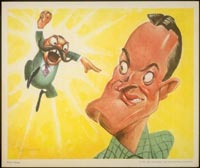
Berman.
Caricature of Jerry Colonna and
Bob Hope.
Lithograph, ca. 1947.
Bob Hope Collection,
Motion Picture, Broadcasting
and
Recorded Sound Division (107A)
|
|

Closing monolog from The
Pepsodent Show.
Typewritten manuscript, May 8, 1945.
Page 2 - Page
3 - Page 4
Page 5 - Page
6
Bob Hope Collection,
Motion Picture, Broadcasting
and
Recorded Sound Division (105.1)
|
Sentiments and Tributes
Bob Hope concluded each of his radio programs
with an acknowledgment of the challenges of the day or a
salute to its heroes. During World War II, the closing monologs
reminded listeners of the importance of the war effort and
the sacrifices being made by the armed forces. Many different
writers contributed to the closing monolog. Shown here is
one writer's contribution. In this case, only one sentence
made it to the final script and was the seventh sentence
in the closing tribute.
|
Opening Monolog of January 13, 1942
The distinctive bookends of a Bob Hope radio
broadcast were the comic opening monologs and the more serious
closing tributes ending with a paraphrased version of Hope's
theme song "Thanks for the Memory." The key components of
the opening monologs were topical references to the events
of the day or the locale of the performance and self-deprecatory
remarks.
|
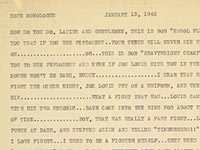
Monolog from The Pepsodent
Show.
Typewritten manuscript, January 13, 1942.
Courtesy of Bob Hope Archives (102a.1)
|
|
|



